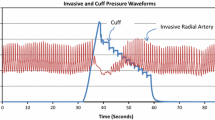Abstract
Resonance in pressure monitoring catheters is a well-known problem which was studied several years ago. Current piezoelectric devices have mechanical properties providing a resonance frequency and damping factor that theoretically assure resonance-free data. However, in particular cases, the coupling between the device, the catheter, and the vascular compliance of the patient could introduce artefacts in clinical settings leading to wrong pressure waveforms and values displayed in the monitor. In this research work we study a laboratory model of a clinical setting to evaluate in which cases the compound (catheter and device) could cause resonances in an unacceptable range. The classical pop-test is expanded for analysing the effect of the catheter. Results indicate that the presence of different catheters may alter significantly the acquired signal, up to an unacceptable level. Particular care should be used in the selection of the appropriate catheter. In particular, smaller diameters introduce higher damping coefficient that could help in avoiding undesired oscillations.










Similar content being viewed by others
References
Antonelli M, Levy M, Andrews PJ, et al. Hemodynamic monitoring in shock and implications for management. International consensus conference, Paris, France, 27–28 April 2006. Intensive Care Med. 2007;33:575–90.
Vincent JL, Pelosi P, Pearse R, Payen D, Perel A, Hoeft A, Romagnoli S, Ranieri VM, Ichai C, Forget P, Della Rocca G, Rhodes A. Perioperative cardiovascular monitoring of high-risk patients: an international consensus. Crit Care. 2015;19:224.
Andrews FJ, Nolan JP. Critical care in the emergency department: monitoring the critically ill patient. Emerg Med J. 2006;23:561–4.
Saugel B, et al. Measurement of blood pressure. Best Pract Res Clin Anaesthesiol. 2014;28(4):309–22.
Lehman LW, Saeed M, Talmor D, et al. Methods of blood pressure measurement in the ICU. Crit Care Med. 2013;41:34–40.
Papadopoulos G, Mieke S, Kuhn HJ, et al. Assessment of the performance of two oscillometric blood pressure monitors using a simulator. Anaesthesist. 1996;45:453–9.
Chatterjee A, DePriest K, Blair R, et al. Results of a survey of blood pressure monitoring by intensivists in critically ill patients: a preliminary study. Crit Care Med. 2010;38:2335–8.
Bur A, Herkner H, Vlcek M, et al. Factors influencing the accuracy of oscillometric blood pressure measurement in critically ill patients. Crit Care Med. 2003;31:793–9.
Araghi A, Bander JJ, Guzman JA. Arterial blood pressure monitoring in overweight critically ill patients: invasive or noninvasive? Crit Care. 2006;10:R64.
Gardner RM. Direct blood pressure measurement—dynamic response requirements. Anesthesiology. 1981;54:227–36.
Wilkinson MB, Outram M. Principles of pressure transducers, resonance, damping and frequency response. Anaesth Intensive Care Med. 2009;10:102–5.
Romagnoli S, Romano SM, Bevilacqua S, et al. Dynamic response of liquid-filled catheter systems for measurement of blood pressure: precision of measurements and reliability of the Pressure Recording Analytical Method with different disposable systems. J Crit Care. 2011;26:415–22.
Kleinman B, Powell S, Kumar P, Gardner RM. The fast flush test measures the dynamic response of the entire blood pressure monitoring system. Anesthesiology. 1992;77:1215–20.
Kleinman B. Understanding natural frequency and damping and how they relate to the measurement of blood pressure. J Clin Monit. 1989;5:137–47.
Romagnoli S, Ricci Z, Quattrone D, Tofani L, Tujjar O, Villa G, Romano SM, De Gaudio AR. Accuracy of invasive arterial pressure monitoring in cardiovascular patients: an observational study. Crit Care. 2014;18(6):644.
Acknowledgements
The research has been performed with institutional funding from University of Florence and AOU Careggi, no sponsorship from other sources is present.
Author information
Authors and Affiliations
Corresponding author
Ethics declarations
Conflict of interest
The authors declare that they have no conflict of interest.
Rights and permissions
About this article
Cite this article
Bocchi, L., Romagnoli, S. Resonance artefacts in modern pressure monitoring systems. J Clin Monit Comput 30, 707–714 (2016). https://doi.org/10.1007/s10877-015-9760-1
Received:
Accepted:
Published:
Issue Date:
DOI: https://doi.org/10.1007/s10877-015-9760-1




